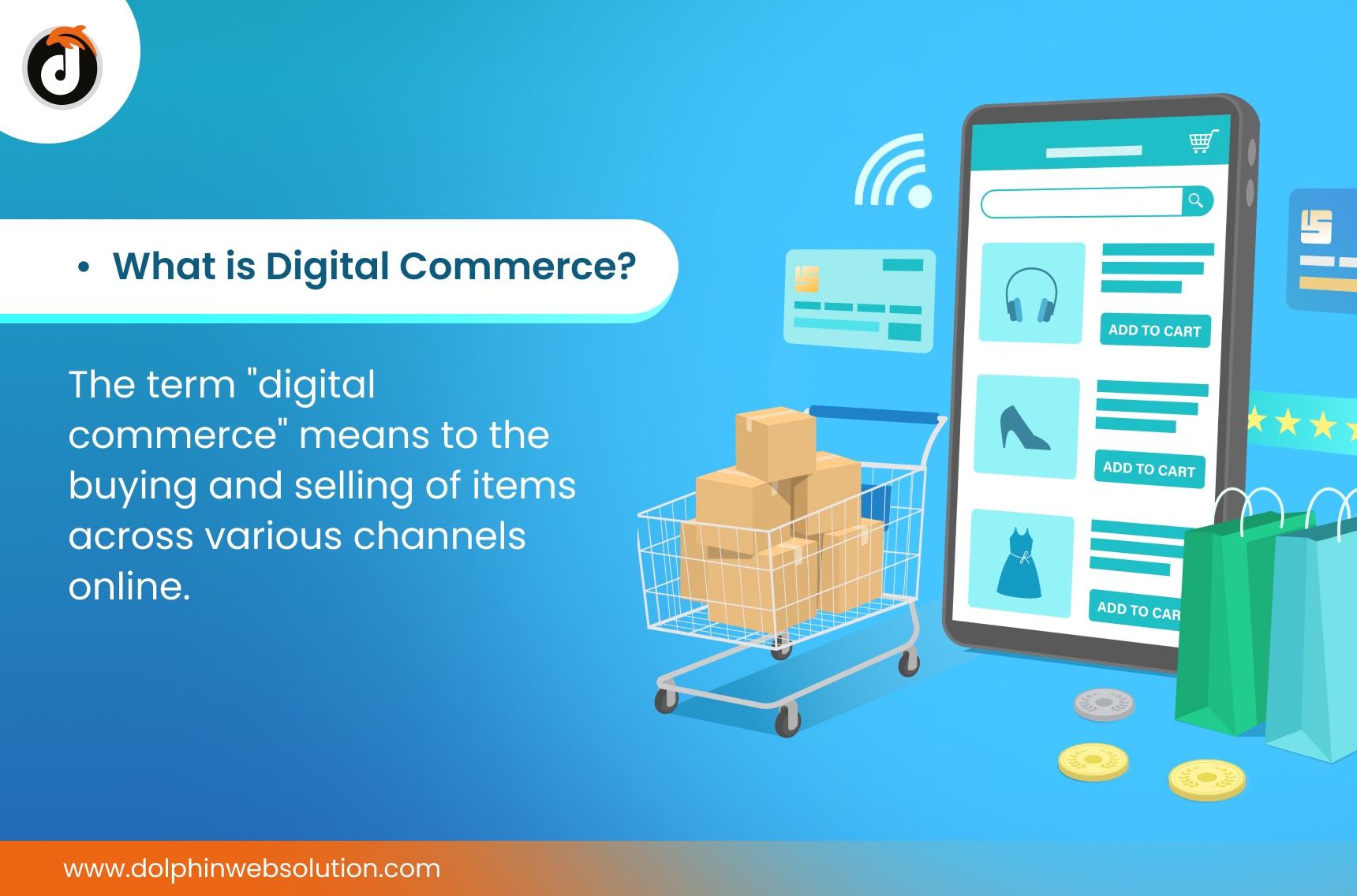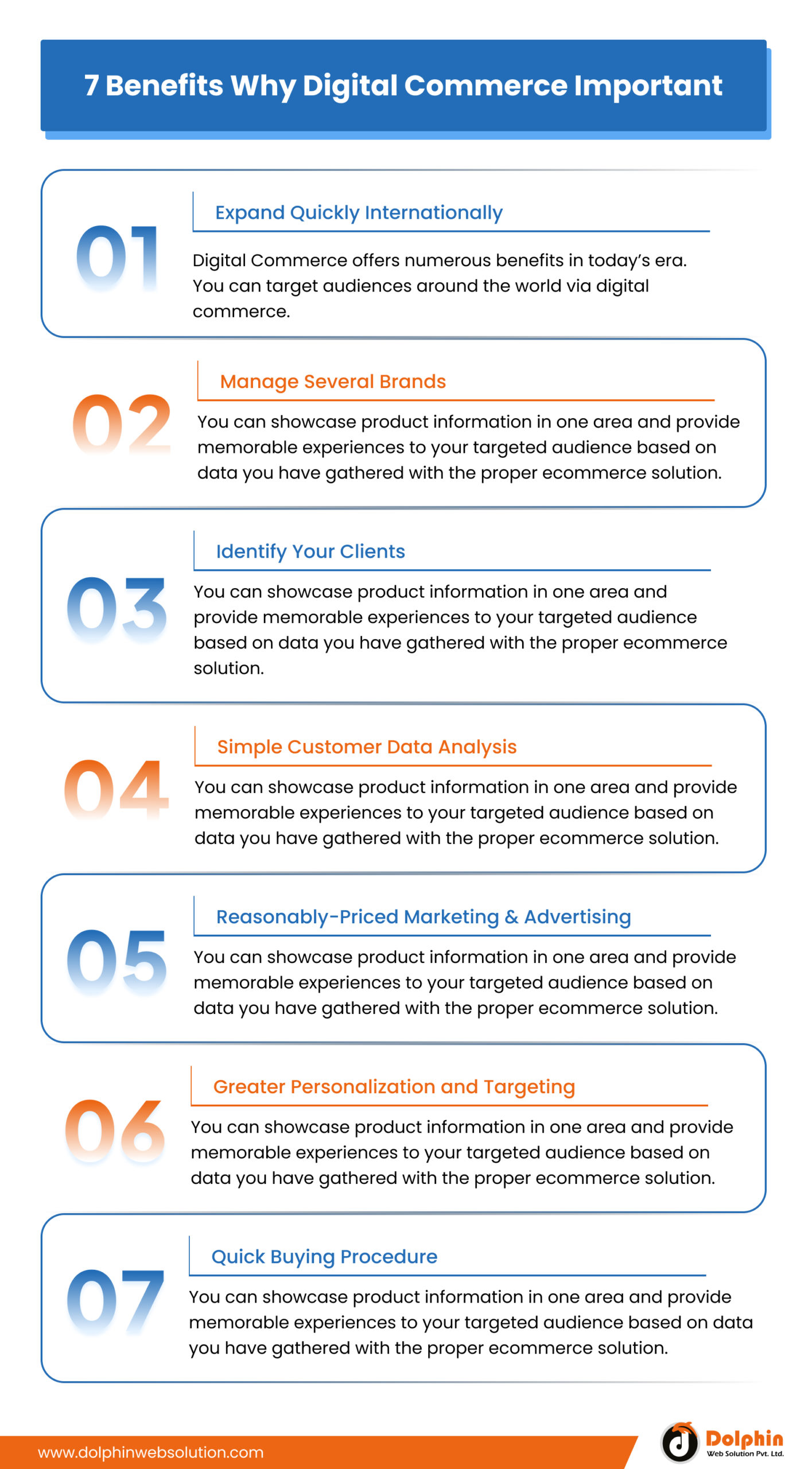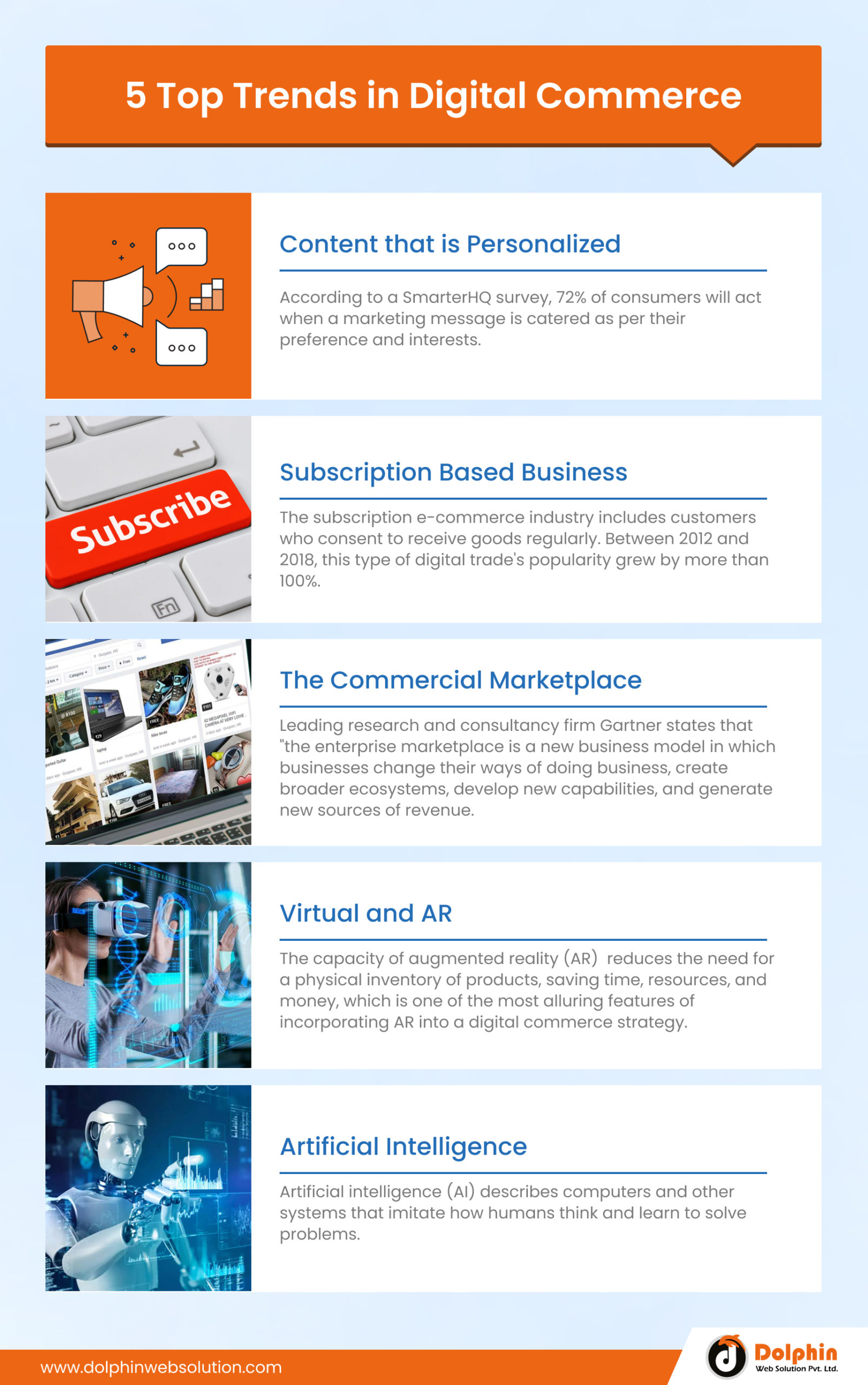Importance of Digital Commerce in Today’s Modern Era

Table of Contents
- 1 Introduction
- 2 What is Digital Commerce?
- 3 Digital Commerce vs. Ecommerce
- 4 How Does Digital Commerce Work?
- 5 Reason for Digital Commerce Growth
- 6 Why is Digital Commerce Important?
- 7 What Does Digital Commerce Include?
- 8 5 Top Trends in Digital Commerce
- 9 Example of Digital Commerce
- 10 5 Tips to Improve Digital Commerce
- 11 Wrapping Up: Choose Your Digital Commerce Partner Wisely
Summary :
Digital commerce is a key factor in today's economy fostering business expansion. Its importance is based on improved business processes, increased market penetration, and individualized experiences. By 2023, this dynamic industry will embrace social commerce and AI-powered personalization trends.
Introduction
Digital commerce has changed from a few years ago. It has a fresh appearance, offers many more factors and actions, and is easily explicable. The continuous pandemic condition has enabled the faultless expansion of digital commerce. Additionally, it has established a foundation for B2C and B2B purchasers, causing half of consumers to make their first online purchase. Therefore, let’s check out why digital commerce is important today.
According to a recent report, the following are some intriguing projections for the future of digital commerce by 2023.
- About 80% of businesses include AI in their digital commerce strategies. Their key performance parameters, like revenue, customer happiness, or cost reduction, will soon improve by at least 25%.
- About 15% of the major online retailers will debut their marketplaces.
- By offering substantial Application Platform-as-a-Service (aPaaS) advancements, quick feature releases, and expansive ecosystems, digital commerce players are anticipated to dominate the market.
- By 2023, US B2B is anticipated to exceed $1.8 trillion.
- In B2B buying, 89% of consumers conduct online research.
- Approximately 95% of purchases will be made through eCommerce by 2040.
What is Digital Commerce?

The term “digital commerce” means to the buying and selling of items across various channels online. Assume your smartphone, laptop, and iPad are all connected to WiFi then you can easily operate business online from anywhere across the world via different channels like social media, Livestream, and other services. “Digital commerce” literally means more than just an online store where purchases and sell of products are made and payments are processed. It includes everything from traditional e-commerce to customized commerce. You can hire an Ecommerce developer for getting your own digital commerce developed.
Digital Commerce vs. Ecommerce
Although “digital commerce” and “ecommerce” are sometimes used interchangeably, they have different meanings. Although they both entail purchasing and selling products or services online, some significant distinctions between the two concepts are vital to comprehend.

How Does Digital Commerce Work?
Digital commerce starts when a customer discovers a company or a product for the first time online. In Google search results, they can find the brand’s domain name, a product listing from a retail aggregator, or an advertisement from their social media feed. Think about a customer purchasing on a website like Amazon. Using a sophisticated algorithm, their website users are shown personalised search results for certain goods. The order in which products appear may vary from customer to customer depending on previous consumer activity, geographic location, and other factors. Analytics are used to understand better how products are presented and sold on a website and how support and customer service requests are handled. Every transaction automatically notifies marketing for the following one. In this view, delivering goods from point A to point B is less important than how customer data is gathered and used to improve the online shopping experience over time.
Reason for Digital Commerce Growth
- Digital commerce enables companies to connect with customers globally, erasing geographic limitations and extending their market reach.
- To fit into clients’ hectic schedules, online shopping offers the convenience of 24/7 browsing and purchasing goods or services.
- Businesses can present various goods and services on digital platforms, catering to specialized markets and consumer preferences.
- Personalized shopping experiences are made possible by cutting-edge data analytics and AI-driven technology, increasing customer engagement and happiness.
- Online firms frequently experience cheaper operating expenses, enabling them to provide competitive pricing and promotions that appeal to budget-conscious customers.
- The widespread use of smartphones and mobile apps allows consumers to purchase more conveniently while on the go, further boosting online sales.
- Digital commerce platforms make it simple to access customer feedback, which influences purchasing decisions. Online reviews and social proof play a key role in purchase decisions.
Why is Digital Commerce Important?
Because of the extending impact of digitalization in both B2B and B2C, we are seeing massive changes in client assumptions and ways of behaving about how they research items or administrations, make buys, or express their image dependability. A study discovered that about a portion of clients (45% of buyers and 56% of B2B clients) might want to pay something else for a superior encounter. They wouldn’t buy a similar brand once more if their experience had been something more.
7 Benefits of Digital Commerce
Digital Commerce offers numerous benefits in today’s era. You can target audiences around the world via digital commerce. Here are some of the major benefits offered by digital commerce.

1. Expand Quickly Internationally
Reaching consumers all around the world is easier to manage and more economical with digital commerce. You must get ready for the logistics of conducting business internationally if you want to expand globally. Even if many consumers buy products from international stores, they hope for rapid, low, or free delivery.
2. Manage Several Brands
With digital commerce, manage many brands concurrently. You can showcase product information in one area and provide memorable experiences to your targeted audience based on data you have gathered with the proper ecommerce solution. You can list various brands online and generate revenue. These help to sell and handle multiple brands to a single customer.
3. Identify Your Clients
You can connect with your customers on all the channels with a digital commerce strategy. This may be a timely text message sent to a consumer while traveling by train for their morning commute, offering a new product. A new mother can benefit by receiving helpful instructions highlighting must-have products from her online business. Whatever you are selling, this tactic enables you to engage with clients uniquely. You are invited into their homes and everyday lives to reach your clients with highly focused, continuing experiences.
4. Simple Customer Data Analysis
Customer data collection and storage are made simple by digital commerce. When they browse or make a purchase from your store, you instantly learn more about them. Even with digital marketing, You can track consumer interactions and buying patterns.
You can also learn helpful information about every consumer from the items they examine but choose not to purchase. This information will help you plan your entire customer experience.
5. Reasonably-Priced Marketing & Advertising
When digital commerce is a significant concern, there are a variety of less expensive advertising and marketing strategies to consider. The most crucial kind of promotion for eCommerce marketplaces is through visual channels. With the addition of aesthetically pleasant and high-quality photographs, videos, and infographics that include all the information a customer could ever want, many advertising tools help to make items more appealing. Creating specialised offers, bargains, and sponsored advertisements can also be viable.
6. Greater Personalization and Targeting
Targeting and personalisation get better as you gain more customer knowledge. Digital commerce helps you keep track of each customer’s purchase patterns, which gives you information on how to employ your marketing campaigns. Targeting gender, geography, and cart abandonment rates in eCommerce is simple.
Since you only promote add-ons when buying a specific item, online upselling and cross-selling don’t make the customer uncomfortable or irritated.

7. Quick Buying Procedure
Everyone is only now keeping up with the speed of this world that is rapidly expanding. The same holds when it comes to buying a product or service. Customers surf the internet, conduct a quick product search, receive immediate results, evaluate the reviews and product descriptions, add the item to their cart, and quickly buy. These simple processes take little time, and in the end, buyers are satisfied because placing an order is fast and straightforward without the difficulties they have while buying offline.
What Does Digital Commerce Include?
- Online Stores and Marketplace
- Detailed product descriptions
- Product images and videos
- Specifications and attributes
- Digital Payment and Transactions
- Shopping Carts and Checkouts
- Customer Reviews and Ratings
- Ratings and reviews for products
- Online help centers
- Live chat and chatbots
- Email and phone support
- Returns and Refunds
- Subscriptions for products or content
- Sales Analytics
- Selling products directly on social media platforms
- Integrating shopping features within social apps
- AR and VR
- Shopping using voice assistants
- CRM systems
5 Top Trends in Digital Commerce

1. Content that is Personalized
According to a SmarterHQ survey, 72% of consumers will act when a marketing message is catered as per their preference and interests. You may become an expert in content personalization to improve user experience and gain your audience’s confidence. Utilising advertisements based on a person’s online activity is one approach to give every member of your target audience. According to data from Instapage, 78% of internet users in the United States are more likely to purchase after seeing personally relevant marketing content. Usually, this kind of information targets a single person or a narrow demographic. Learn the purchase habits of your audience and design your content around that information. Customer relationship management (CRM) solutions might help gather visitor data.
2. Subscription-Based Business
The subscription e-commerce industry includes customers who consent to receive goods regularly. Between 2012 and 2018, this type of digital trade’s popularity grew by more than 100%. Subscription commerce has become a well-liked option in various industries, including food and beverage, beauty, health and wellness, spirituality, fitness, and books; these are some examples. In an interview with ConsumerAffairs, Kathy Greenler Sexton, CEO & Publisher of Subscription Insider, said: “I would be surprised if enterprise decided not to jump into this hot market with the anticipated compound annual growth rate (CAGR) of the global automotive subscription services market through 2022 at 71%.” She makes a valid point given the success of companies like Netflix and Spotify, which have monetized through subscription commerce.
3. Commercial Marketplace
Leading research and consultancy firm Gartner states that “the enterprise marketplace is a new business model in which businesses change their ways of doing business, create broader ecosystems, develop new capabilities, and generate new sources of revenue. The industry even published research on companies using enterprise marketplaces, including Toyota Material Handling, Best Buy Canada, and H&M (Afound). The firms above aren’t the only ones utilising enterprise marketplaces, which are known for assisting businesses in extending their consumer reach.
4. Virtual and AR
Why not give your audience a realistic digital shopping experience? With sensory stimulation, augmented reality (AR) technology superimposes visuals onto a user’s perception of the outside world. Effects that replicate genuine sounds, feelings, sights, and, in certain circumstances, smells may be used in augmented reality. The capacity of augmented reality (AR) reduces the need for a physical inventory of products, saving time, resources, and money, which is one of the most alluring features of incorporating AR into a digital commerce strategy.
5. Artificial Intelligence
Artificial intelligence (AI) describes computers and other systems that imitate how humans think and learn to solve problems. When AI is applied to digital commerce, it examines user information (such as age, gender, and interests) to provide customers with highly customised adverts. A Gartner poll that found 59% of respondents were looking for ways to improve their AI strategies underlined the advantages of AI. The remaining 41% have already included automated tools in their digital commerce approach.
Example of Digital Commerce
- Sekel Tech: The best example of digital commerce is Sekel Tech, which provides complete digital commerce solutions and services to support your company’s rapid expansion. Whether start-ups, small businesses, or major corporations, all business kinds are the ideal fit for the Sekel Tech Suite of products and services.
- AppSumo: An online daily deal website called AppSumo offers products and services that are provided digitally. Develop your company by locating, purchasing, and reselling digital goods. Numerous digital businesses, including Evernote, MailChimp, DepositPhotos, and many others, have partnerships with AppSumo.
- Shopify: One service that you can use is Shopify Development. Your domain name can be linked to the website where you host your online store. A few services it offers are product administration, order management, numerous payment channels, fundamental customer management, limitless bandwidth, and more than 100 professional themes.
- Intercom: Customers can establish relationships through conversational, messenger-based interactions with a US-based software business, Intercom. They created a framework for dialogic connections. You can scale casual interactions for every consumer with their solutions without overtaxing your employees.
- Volusion: An example of cloud-based digital commerce is Volusion. In addition, Volusion provides eCommerce software, marketing, and web design services. Online storefronts can use the application to maintain information and design product pages that are search-engine friendly.
5 Tips to Improve Digital Commerce
Online buyers seek quick responses and simple solutions. By continually enhancing their customer service, sales, and marketing communication methods, e-tailers that cater to their clients in this way will gain an advantage. Communication channels and automation are two common strategies to enhance digital commerce customer service.
1. Know Your Audience
You should use two different forms of analytics on your website. Traffic analysis reveals how and from where your audience is discovering you. This helps you determine the marketing tactics you should use to increase visitors. You may also utilise a variety of helpful analytics tools to learn more about the region, gender, and age of your audience. You may design your target persona by analysing this data, which is a beneficial exercise that will aid in the creation of more effective marketing plans. Using behavioral analytics, you can see what your website’s visitors are doing. For instance, you can use Hotjar or Hotjar substitutes to obtain a heatmap for your website. You can use these tools to see where users click on your website. Using this information, you may better position the elements that receive the most interaction, which should increase conversion rates.
2. Create a Presence on Social Media
Establishing a presence in areas where your target audience congregates is essential. In essence, this refers to social media, as billions of users spend more than three hours each day surfing social media sites, a trend that is undoubtedly influenced mainly by the pandemic.
Improving your social media marketing abilities is the most excellent method to get started if you’re hesitant. Once you’ve mastered the fundamentals, you can use your newly acquired social media expertise to create a brand-centred community.
3. Increase Client Loyalty
From the beginning, put your attention on fostering customer loyalty. Offering prizes is one of the most successful methods to accomplish this. Create a loyalty programme where members occasionally receive a discount or exclusive deal. Share your loyalty awards and discount coupons on social media. You might also think about producing branded personalised goods and giving them away. You might also include Google advertisements in your sales activities to attract new customers to your brand. As a result, you’ll reward your current clients and draw in new ones to your online store.
4. Show Off Your Client Testimonials
Customer evaluations encourage purchases, foster trust among potential clients, and establish a reputation. Positive customer feedback can also aid in SEO. Using a Shopify reviews app is one method for displaying client reviews. This saves you time and effort by enabling your store or e-commerce site to gather thoughts and automatically highlight the best ones.
5. Engage Influencers
Thousands of influencers are open to working together. This may be one of the best strategies for boosting online sales. By collaborating with influencers, you can gain access to various audiences through an ambassador who has the followers’ trust. Since conversion rates for lesser influencers can be exceptionally high, this is particularly true for them. Explore several influencer search platforms to identify prospective partnership opportunities if you need help figuring out where to begin.
Wrapping Up: Choose Your Digital Commerce Partner Wisely
The importance of digital commerce is more apparent than ever in the changing environment of the current era. It is clear that digital commerce has gone beyond simple convenience to become a crucial engine of economic growth and customer engagement, as discussed through this in-depth overview of its advantages, current trends, and helpful advice. The combination of frictionless transactions, individualized experiences, and broad market penetration highlights its crucial role in influencing how companies and customers interact. The transformational potential of digital commerce is further highlighted by the trends of 2023, which range from AI-driven customization to immersive virtual shopping. Your Ecommerce Developer can help you catch up with all the latest trends in digital commerce and stay ahead of the competition. Adopting a customer-centric strategy, leveraging emerging technology, and upholding a strong cybersecurity framework stand out as vital tactics to successfully navigate this landscape. In summary, organizations that want to succeed in the digitally enabled present and future must embrace digital commerce. This isn’t simply a choice; it’s a strategic need.

